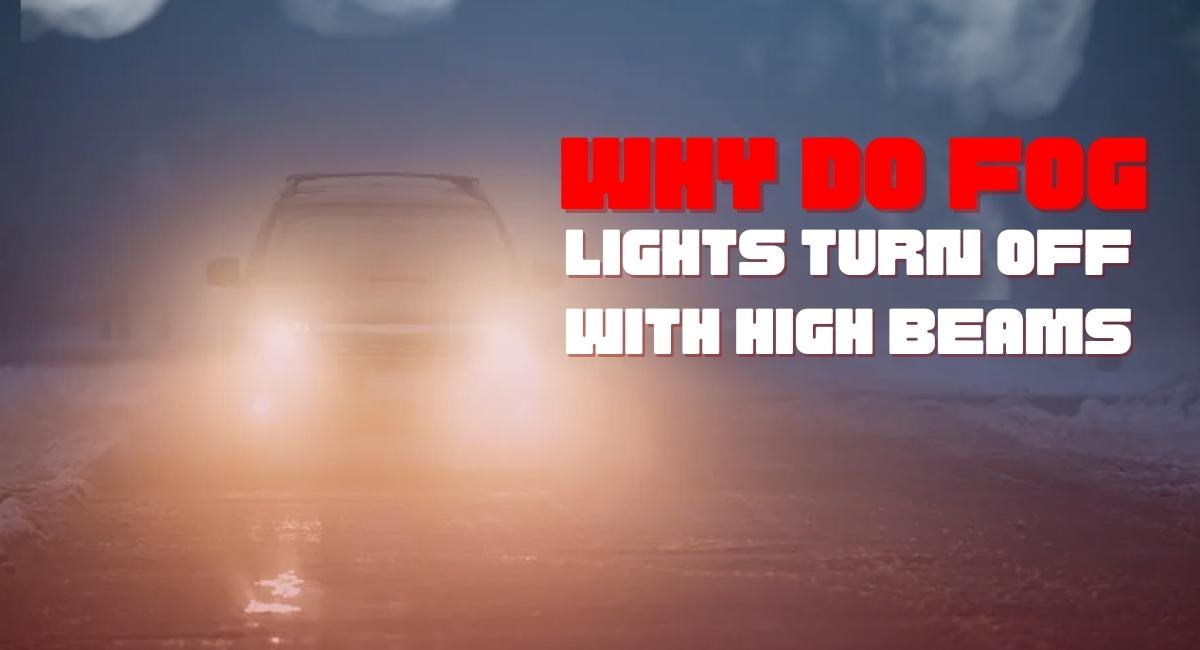Have you ever wondered why your fog lights automatically turn off when you switch on your high beams? Or you may wonder whether using high beams in foggy conditions is safe. The answer lies in understanding the operation of fog lights and high beams, a safety feature designed to protect you and fellow motorists on the road.
Fog lights turn off when high beams are activated because they reduce visibility, causing the bright light to reflect off the fog instead of penetrating it. Fog lights intend to improve visibility during adverse weather conditions that diminish your capacity to see the road ahead.
This comprehensive guide will look into these questions:
- The purpose of fog lights and high beams
- Why are fog lights designed to turn off with high beams
- Whether you can use high beams in fog
- A comparison of fog lights vs high beams
- How to keep fog lights on with high beams
The Purpose of Fog Lights
To comprehend why fog lights and high beams interact the way they do, it’s essential first to understand the primary purpose of fog lights.
Fog lights enhance visibility in adverse weather conditions, such as fog, mist, heavy rain, or snow. Unlike standard headlights, fog lights are mounted low on the vehicle’s bodywork and angled at a steeper angle than regular headlights.
The unique design of fog lights results in a beam pattern that is wide and flat, with a distinct cutoff at the top. This design serves a crucial function: it reduces the light that reflects off the fog or precipitation in front of the vehicle.
The primary objective of fog lights is to illuminate the road directly in front of the vehicle, enabling the driver to navigate safely and cautiously at lower speeds in conditions where standard headlights might be inadequate.
Moreover, you will notice that rear fog lights are intense red lights, similar in brightness to brake lights and enhance your vehicle’s visibility to those approaching from behind. Switching them off when other cars are behind you is crucial to prevent excessive glare. While it is rare to find rear fog lights in American cars, they are mandatory in European countries.
High Beams and Their Role
High beams, on the other hand, are a powerful source of light that provides enhanced visibility in dark or poorly lit environments. They operate when driving on unlit rural roads, highways or at night to illuminate a significant portion of the road ahead.
High beams’ design casts a strong, far-reaching light pattern, making them valuable for identifying potential hazards at a distance.
However, the intensity and reach of high beams can create issues when used in conditions where fog or precipitation is present. It is where the conflict between fog lights and high beams arises.

Reasons Why Fog Lights Turn Off with High Beams
One of the critical reasons why fog lights turn off when high beams are activated is the potential for conflicting light patterns. Fog lights intend to provide a comprehensive, low-reaching beam that minimizes reflection of the fog or precipitation.
In contrast, high beams cast a robust, high-reaching beam that can cause excessive glare and reflection when used in foggy or rainy conditions. Even standard low-beam headlights tend to reflect light off the fog ahead during such conditions.
Many vehicles have systems that automatically deactivate fog lights when the driver activates the high beams to ensure safety and prevent dangerous glare. It serves a dual purpose: it prevents excessive light scattering in adverse weather conditions and encourages drivers to use the appropriate lighting.
Besides being a safety concern, turning off high beams on foggy roads is legally required. State laws in the USA dictate that cars can only have 4 sources of light on simultaneously. High beams are two light sources, leaving only room for two additional sources.
But what happens when you have installed aftermarket fog or driving lights that don’t turn off with high beams? Well, this is considered technically illegal. While not guaranteed, receiving a traffic ticket for non-compliance is possible.
High beams count towards the maximum allowed sources of light. Vehicles with off-road lights mounted higher than factory headlights are illegal. Off-road lights should only operate when the vehicle is off-road.
Can You Use High Beams in Fog?
Now that we understand the purpose of fog lights and the role of high beams let’s address whether it’s safe to use them in foggy conditions. The short answer is no; using high beams when driving in fog is generally unsafe.
Fog creates a unique optical challenge. The tiny water droplets in the fog scatter light, reducing visibility and the illusion of a “white wall” effect.
When you switch on your high beams in such conditions, the intense light is scattered by the water droplets, creating a blinding glare that can severely impair your vision. It is especially hazardous when other vehicles are on the road, as the glare can blind oncoming drivers and increase the risk of accidents.
In essence, using high beams in fog fails to improve visibility and can be a safety hazard. Therefore, relying on your vehicle’s fog lights or, if necessary, your low-beam headlights is advisable when driving in foggy conditions.
Fog Lights vs High Beams: A Comparison
To further clarify the differences between fog lights and high beams, let’s compare the two in terms of their purpose, beam patterns, and effectiveness in various situations.
Purpose
Fog Lights are designed for use in adverse weather conditions to improve visibility near the vehicle and reduce the reflection of fog or precipitation. On the other hand, high beams are intended for use in dark or unlit environments to illuminate a more significant portion of the road ahead.
Beam Patterns
Fog Lights emit a wide, flat beam with a distinct cutoff at the top to minimize reflection and glare. But if you want a robust and far-reaching beam with no precise cutoff, providing maximum visibility at a distance, then you can work with high beams.
Effectiveness
Fog Lights are highly effective in reducing reflection and enhancing visibility in fog, heavy rain, and snow.
On dark roads, high beams effectively illuminate distant objects but are unsuitable for use in adverse weather conditions.
However, it’s worth noting that many modern front fog lights serve more as a stylistic feature than a practical necessity, rendering them limited practical use. Spotting a car with fog lights during clear weather indicates an imprudent driver.
Also, a recent trend is that fog lamps are starting to disappear. For instance, luxury car manufacturers have discreetly excluded front fog lights from current models, including Audi, Cadillac, Lincoln, Mercedes-Benz, and Hyundai’s latest Genesis lineup.
How Do You Keep Your Fog Lights On With High Beams
While keeping your fog lights on with high beams is illegal, it may be impossible sometimes. Many vehicles’ designs automatically turn off the fog lights when the high beams are activated. This design intends to prevent excessive glare and reduce the risk of blinding oncoming drivers in situations where you use high beams.
However, if you have a specific need to use both fog lights and high beams simultaneously, you should consult your vehicle’s owner’s manual and consider the following options:
Check Your Vehicle’s Manual
The first step is to consult your vehicle’s owner’s manual. It will provide information on the lighting controls and whether specific settings or overrides allow you to keep the fog lights on with the high beams. Some vehicles may have a dedicated switch or setting that lets you do this.
Aftermarket Modifications
You may consider aftermarket modifications if your vehicle has no built-in option to keep fog lights on with high beams. It typically involves rewiring or installing a separate switch to control the fog lights independently from the high beams. However, it’s important to check local regulations and ensure that such modifications comply with the law in your area.
Use Alternatives
While you may want to use both fog lights and high beams simultaneously, consider alternative ways to enhance visibility in specific driving conditions. For instance, you can use your low-beam headlights and fog lights to achieve a similar effect, as low beams are less likely to cause glare than high beams.
Also Read: 7 Ways to Lock Mercedes While Running
Conclusion
This comprehensive guide explored why fog lights turn off when high beams are activated and addressed the safety concerns related to using high beams in foggy conditions. Fog lights and high beams serve distinct purposes and excel in specific situations. While fog lights are tailored for adverse weather conditions, high beams are best for dark, unlit roads. So, the next time your fog lights turn off with your high beams, you’ll know that it’s not just a design quirk—it’s a deliberate measure to keep you safe on the road.
